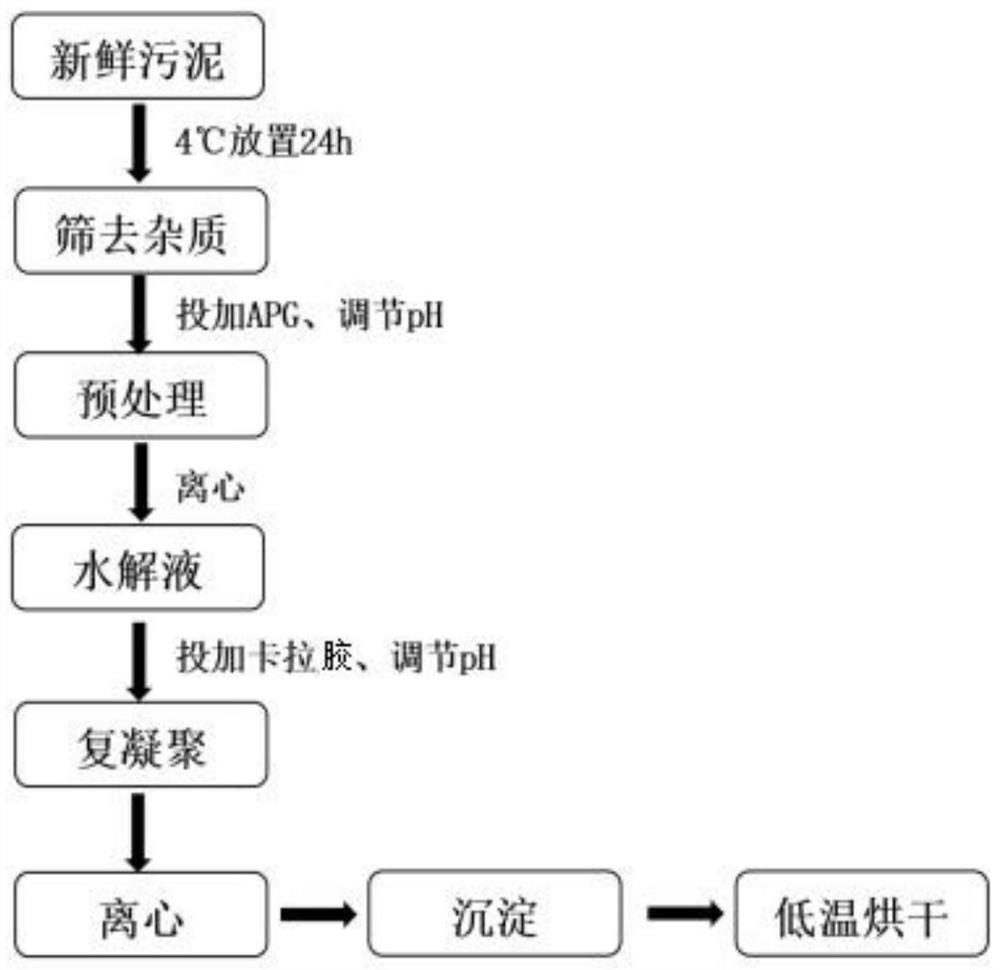A method for efficient recovery of protein from excess sludge
A technology for excess sludge and protein, which is applied in peptide preparation methods, plastic recycling, sludge treatment, etc., can solve the problems of inapplicable protein recovery, complex protein components, and low protein content, so as to promote sludge dispersion and avoid Effects of excessive consumption, rapid biodegradability
- Summary
- Abstract
- Description
- Claims
- Application Information
AI Technical Summary
Problems solved by technology
Method used
Image
Examples
Embodiment 1
[0032]The present embodiment is a method for efficiently recovering protein from excess sludge (WAS), the method comprising the following steps:
[0033] Step 1: After the sludge taken out from the secondary sedimentation tank of the sewage treatment plant is allowed to stand at 4°C for 24 hours, the supernatant is discharged with a straw, and the sludge is filtered with a sieve with an aperture of 1 mm. The impurities in the sludge were screened out, and finally the treated sludge was stored at 4°C for subsequent experiments, and the SS of WAS was adjusted to be about 10,000 mg / L to obtain excess sludge. This treatment process is mainly to screen out the impurities in the WAS and prepare for the subsequent pretreatment.
[0034] Step 2: Take the treated excess sludge WAS in an anaerobic reactor with an effective volume of 500mL, adjust the pH of WAS to 10.0±0.2, and then add 0.3g / g SS APG at a temperature of 35±1℃ After the reaction was carried out, the reaction bottle was f...
Embodiment 2
[0040] The steps in this example are the same as those in Example 1, except that the dosage of APG in this example is 0.1, 0.2, 0.4, and 0.5 g / gSS, and the recovery rate of protein in this example is less than 90%. %, but above 80%.
[0041] Under the conditions of APG dosage of 0.3g / gSS and pH of 10.0, the hydrolysis effect of WAS was the best, the released protein content was high, and the sludge disintegration effect was obviously improved. Compared with the unpretreated sludge, when the dosage of APG was 0.3g / gSS and the pH was 10.0±0.2, the dissolution amount of SCOD of WAS increased from 200.2mg / L to 4500.0mg / L, and the dissolution amount of protein From 17.1mg / L to 1009.7mg / L, the dissolved amount of polysaccharide increased from 10.7mg / L to 663.9mg / L, the SCOD content increased by 22.5 times, the protein content increased by 59.0 times, and the polysaccharide content increased by 61.87 times.
Embodiment 3
[0043] The steps in this embodiment are the same as those in Embodiment 1, except that the preprocessing time in this embodiment is 0, 4, 8, 12, 24, 32, and 48 hours. During WAS hydrolysis, the highest concentrations of SCOD, protein and polysaccharide increased with the increase of APG dosage, but changed little with time. When the reaction time was 2h, the highest concentrations of SCOD, protein and polysaccharide were 3250.1, 798.9, and 478.1 mg / L, while the highest concentrations of SCOD, protein and polysaccharide in the blank group were only 200.2, 17.2, and 10.9 mg / L. When the reaction time is higher than 8h, the dissolution amount of protein decreases, which is not conducive to the efficient recovery of protein.
PUM
| Property | Measurement | Unit |
|---|---|---|
| recovery rate | aaaaa | aaaaa |
Abstract
Description
Claims
Application Information
 Login to View More
Login to View More - R&D
- Intellectual Property
- Life Sciences
- Materials
- Tech Scout
- Unparalleled Data Quality
- Higher Quality Content
- 60% Fewer Hallucinations
Browse by: Latest US Patents, China's latest patents, Technical Efficacy Thesaurus, Application Domain, Technology Topic, Popular Technical Reports.
© 2025 PatSnap. All rights reserved.Legal|Privacy policy|Modern Slavery Act Transparency Statement|Sitemap|About US| Contact US: help@patsnap.com

